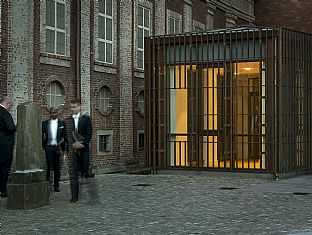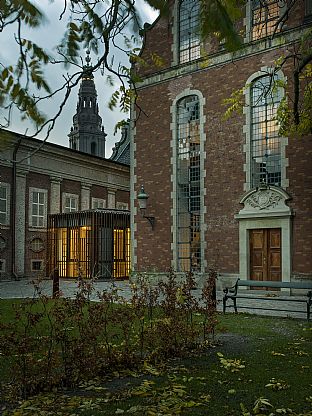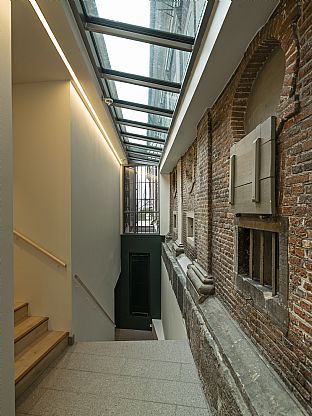16.11.2015
DEDICATION OF THE NEW PARISH HALL AT THE CHURCH OF HOLMEN
The Church of Holmen is now ready to invite people in to the new C.F. Møller parish hall, which has been sensitively fitted in between the large chapel and the church itself, with part of it established underground.
C.F. Møller is behind the new parish hall at the Church of Holmen in Copenhagen. The church has been in need of new employee facilities such as offices, parish hall and toilet facilities for the disabled for a long time.
The new extension is wedged in discreetly between the main church building and the Large Chapel, thereby replacing a previous building from the 1830s – ’Lille Skriftestol’ [Eng: the Little Confessional]. Apart from a parish hall, which can be used for lectures, meetings and lots of other purposes, new offices and facilities for church employees have been set up. One important aspect of the construction of a new parish hall in as important a location as the Church of Holmen is ensuring that the new building is accommodated with the greatest possible consideration for the location.
"The idea was for the extension to have a present-day edge, while always showing respect for the old church. I think that's what we have achieved too. We now have space for our many activities, and can provide our employees with the conditions prescribed by the public authorities," says Anders Friis, chairman of the parish council for the Church of Holmen, who stresses that until now it has been difficult for the disabled and those with mobility problems to use the church, just as church employees have had very poor conditions in which to carry out their duties
New life for the old church
The Church of Holmen was consecrated in 1619. The church was originally an anchor foundry which was established by King Fredrik II. The anchor foundry cast huge anchors and anchor chains for the Danish fleet. When the Danish Navy and their families were to have their own church, King Christian IV had the anchor foundry converted into the Church of Holmen. Afterwards, some additions were made to the church including the Chapel Hall and a chapel dedicated to naval hero Niels Juel. The history of the church contains many alterations up to 1834 and the new extension is a natural continuation of that history.
Over the years, the Church of Holmen survived the great fire of Copenhagen and is therefore Copenhagen's oldest example of renaissance architecture. The church is used a great deal by the Danish Royal Family – for example, Queen Margarethe was married here.
"By building the extension between the church and the chapel, we have retained the greenery of the church garden for the benefit of the people of Copenhagen who come past and want to have a green open space, and I am really glad about that," says Anders Friis.
The parish hall has been provided with overhead lighting via narrow tracks in the ceiling and the walls are timber-lined. The building is the same height as its predecessors, and its façade and roof are finished in copper as a lattice – extending from the internal façade. The modern design has shown respect for the location: The copper takes its inspiration from the copper roof of the Little Confessional, and the openings of the latticework are repeated in the astragal bars on the church's high windows.
Historical discoveries at the construction site
From 1619 to 1851 the green areas around the church were used as a cemetery for naval people and their families. For that reason, archaeologists from the National Museum became involved in the project, since it would have to be excavated for the new extension.
147 adults and 19 children were found to be buried in the excavation area. Among these was one man who had become old for his time, between 45 and 60. He was toothless and suffered from osteoporosis of the spine and neck.
"That is one of the most interesting discoveries we have made for a long time," explains Museum Inspector at the National Museum, Niels Engbjerg.
"There have been many examinations of skeletons from mediaeval burials but, on the whole, nothing from the 17th to the 19th centuries. So, for that reason, we were particularly concerned with carrying out the excavation work painstakingly.
To provide insight into the parish
In addition, the archaeologists were surprised to find a lot of ceramic material in the soil, since Christian graves as a rule do not contain many burial goods, according to Niels Engbjerg.
"We also found the foundation of the chapel in which Niels Juel's casket originally stood until it was moved over into the new chapel where his monument stands today. After that the chapel was demolished. The new extension has thus been built where Niels Juel was originally buried," he says.
With these numerous discoveries, the National Museum hopes to gain greater knowledge about the lives lived by the people in the Church of Holmen parish. At the Anthropology Laboratory, the skeletons will be examined for traces of various diseases, which is also an important element in telling the history of the parish.
The extension was designed by C.F. Møller in collaboration with engineering firm Eduard Troelsgaard. The building has been erected partly with the support of A.P. Møller Fonden.







